
Original Link: https://www.anandtech.com/show/1993
ASUS A8R32-MVP: Taking the Overclocking Route via the 0404
by Gary Key on April 20, 2006 3:00 AM EST- Posted in
- Motherboards
The ASUS A8R32-MVP has been a lightning rod of discussion on the Internet since its release over a month ago. After receiving extremely positive reviews by the vast majority of websites at launch, the board acquired a somewhat tarnished image within the enthusiast community shortly after retail availability.
Why the tarnished image? A number of issues surfaced after users had time to utilize the board and experiment with varying component combinations. Issues ranged from the boards inability to properly power-up while in an overclocked condition, ASUS applications and Creative drivers not playing nice together, a humming turning to whining noise when utilizing certain memory modules, game play lag while online, stuttering in graphic intensive games, random benchmark scores, RAID 5 issues with the ULi SATA controller, poor HTT overclocks with synchronous memory settings.... You can start to understand the type of issues early adopters faced with this board.
While the majority of these issues were quickly rectified by ASUS with the 0311 BIOS release a few weeks ago - or in some cases like the humming memory, replacement units - the board's reputation continued to be in question when it came to enthusiast level overclocking. It was not so much the board's ability or not to reach high HTT levels but rather its inability to run memory synchronously at the upper HTT levels. In fact, users have experienced issues reaching the 300HTT level, considered the minimum HTT overclock setting now for an enthusiast board, with a synchronous memory ratio and command rate setting of 1T.

ASUS, along with assistance from ATI, spent the last couple of weeks working on a BIOS update that would further improve the board's compatibility with a broad range of memory types, CPUs, and memory controller revisions, but more importantly to the enthusiast, improved overclocking capabilities. The result of this work is the recently released BIOS 0404 that can be downloaded from ASUS' website. While there are not any new BIOS options or layout changes since the 0311 revision, significant work has progressed on the underlying core that has reportedly improved HTT overclocking levels and memory compatibility.
Our article today looks at the improvements we discovered in overclocking our retail board along with some interesting results along the way. We will not be reviewing the features or general aspects of the board again but will instead focus our efforts on the results obtained with BIOS revision 0404 while operating the memory in synchronous mode. We will refer to the synchronous memory settings as 1:1 memory ratios in the balance of the article for simplicity and the fact this term is still widely used. If further information and details about the Asus A8R32-MVP capabilities are required you can refer to our initial review.
Now let's take a closer look at the testing results of the new BIOS and figure out if progress has been made or not.
System Configuration
| System Configuration | |
| Processor: | AMD Athlon 64 4000+ (San Diego) |
| CPU Voltage: | 1.575V (1.400V default) |
| Memory: | 2 x 512mb OCZ Technology PC4800 Platinum Edition DDR-400 CL2-2-2-7, 1T base settings |
| Memory Voltage: | 2.70V standard, up to 2.85V overclocked |
| HT Multiplier: | 5x - 200HTT ~ 254HTT 4x - 255HTT ~ 350HTT |
| Cooling: | Tuniq Tower 120 |
| Power Supply: | PC Power and Cooling 850 SSI |
| Hard Drive(s): | 2 x Maxtor MaXLine III 7L300S0 300GB 7200 RPM SATA (16MB Buffer). |
| Video Cards: | 1 x EVGA 7900GTX (PCI Express) for all tests. |
| Chipset Drivers: | ULi 2.20 M1575 |
| Video Card Drivers: | NVIDIA nForce 84.21 WHQL |
| Operating System: | Windows XP SP2, full updates |
We did not utilize the original board in our review and instead opted to purchase a retail board from NewEgg. Our test unit sports revision 1.03G and arrived with BIOS 0201 flashed on the board. We promptly flashed the board to BIOS revision 0311 in order to run our base test numbers before loading BIOS revision 0404 for testing. Our drive image consists of our full test suite along with AVG anti-virus and QuickTime Pro 7.0 running in the background during testing. All operating system updates for Windows XP SP2 have been installed along with the Windows Firewall being activated during all tests runs.
Worth noting is that our board does emit the humming or whining noise associated with certain Infineon based memory modules from varying suppliers. While the 0311 BIOS and subsequently the 0404 BIOS have reduced this sound, it has not been eliminated. New board replacements have solved this issue for the majority of users, so we can only assume that a substandard lot of boards was initially shipped to retailers. We will be returning our board for replacement shortly.
Our goal is to ensure the software load mirrors that of a typical user system during testing. Our test results utilize current game engines that are balanced between CPU and GPU operations except for F.E.A.R. which is GPU constrained. Our hardware choices consist of high-end components that certainly assist us in reaching the reported results but should be seriously considered when purchasing an enthusiast level board. Our recommendation is to not skimp on the power supply, memory, or video card choices when building this level of system.
Test Setup
Our standard system configuration was flashed to BIOS version 0311 with the AFUDOS program. We configured the system to our baseline BIOS settings, loaded our test suite image, and ran Sandra 2005 Pro burn-in for two hours. Our next step was optimizing the BIOS memory timings, benchmarking our test suite, completing SuperPi 8M, and then running Prime95 for 20 minutes to ensure the stability of the system. If at any point during our test runs a benchmark failed, we reduced our HTT or Memory settings until all tests completed successfully. In addition to our benchmark test suite each setting reported was required to complete a two hour on-line gaming session utilizing Battlefield 2 and City of Heroes.
While we normally utilize Prime95 for a minimum of 4 hours, generate a SuperPI 32M reading, and play on-line for six hours, these tests were shortened based upon our prior testing experience with this product. We feel extremely comfortable with the reported results since our test suite completed successfully and the system had no issues running Prime95 and SuperPI at the reduced settings for three cycles.
After completing this test process with the 0311 BIOS, we flashed the system to BIOS version 0404 utilizing the AFUDOS program. We then reset the BIOS to standard default settings, rebooted, and entered back into the BIOS to configure our baseline BIOS settings. We proceeded to complete our test suite routine in the same manner as before. It should be noted that if you are updating your BIOS via the ASUS Windows Update application, we advise that you flash the BIOS twice to ensure it is programmed correctly. We have had several users experience performance and stability issues after utilizing WinFlash methodology, and the problems were solved by reflashing the BIOS again.
Base Performance Results:
BIOS Revision Comparison at Stock HTT, 1:1 Memory, Command Rate 1T
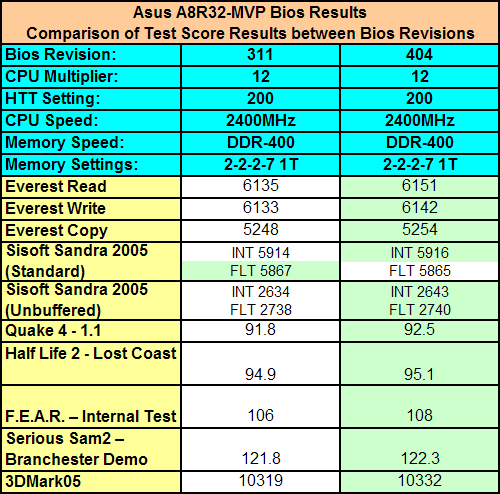
The base performance differences between the 0311 and 0404 BIOS versions are indistinguishable in the reported test results. Although we have limited the reported scores when compared to our entire test suite, the differences in other applications were also minimal between the two BIOS releases. There is no clear winner at stock settings except in F.E.A.R. where the same 2 FPS difference existed in each test run. Our overclocking results between the two BIOS releases only showed a 1%~1.5% delta in favor of the 0404 BIOS, but these results are well within the mean deviation of our benchmarks. Let's see if there are any improvements in the base overclocking tests.
Overclocking Results:
BIOS Revision Comparison at Maximum HTT, 1:1 Memory, Command Rate 1T
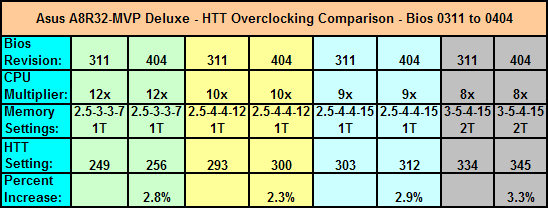
Our testing result with this particular board does indeed show a small but measurable increase in the overclocking capability with the 0404 BIOS at CPU multiplier settings of 8, 9, 10, and 12. In our testing we were able to reach a 315HTT setting with the 9X CPU multiplier but could not complete our game benchmarks even though the board passed the Prime95 and SuperPI tests. We then reduced the HTT setting to 310 and were able to complete our game benchmarks, Prime95, and SuperPI but 3DMark05 would fail. Finally, at a HTT setting of 312 with a 9X CPU multiplier the system would pass our test suite three consecutive times. We witnessed oddities like this throughout our testing regimen and are still investigating this issue.
While this BIOS update certainly did not generate the type of overclocking improvements some enthusiasts were expecting or demand, it has improved. In fact, we're able to boot into settings that were not possible before for both a system POST and Windows XP startup. These incremental changes could mean the difference between reaching or exceeding a 300HTT level with the memory at a 1:1 ratio and a command rate of 1T. Now that the DFI CFX3200 and Abit AT8-32X are available, it will be interesting to see how well the ASUS board measures against two companies known for their BIOS and overclocking skills.
Overclocking Performance
The overclocking performance screenshots allow for a better comparison on the actual overclocking capabilities and settings utilized during for our test suite. For more details on the BIOS settings utilized please refer to the Overclocking and Memory chart below or click on the screenshots for an enlarged image of specific memory settings.
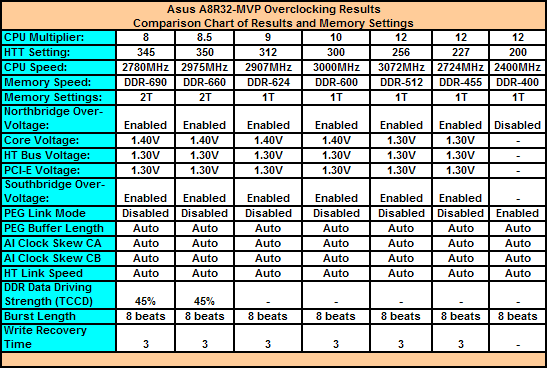
The ASUS A8R32-MVP offers a wide range of BIOS settings for improving performance. We have listed the base settings utilized during testing as well as additional important details within the BIOS. The memory and CPU voltages along with timings will be based upon the components utilized and their capability. We caution anyone overclocking their systems to be aware that failures can and will occur - in our case they occurred quite often.
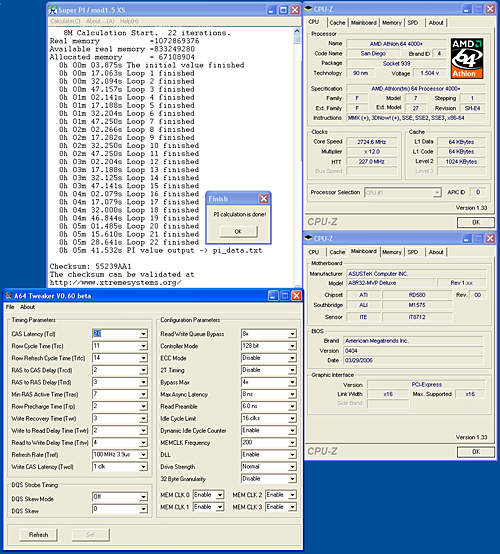 |
| Click to enlarge |
Our first test is designed to see how high we can push the HTT setting while retaining the stock memory settings. This is more an indication of memory performance than overall system capability. The board did reach a stable 227HTT and would actually POST at 230HTT.
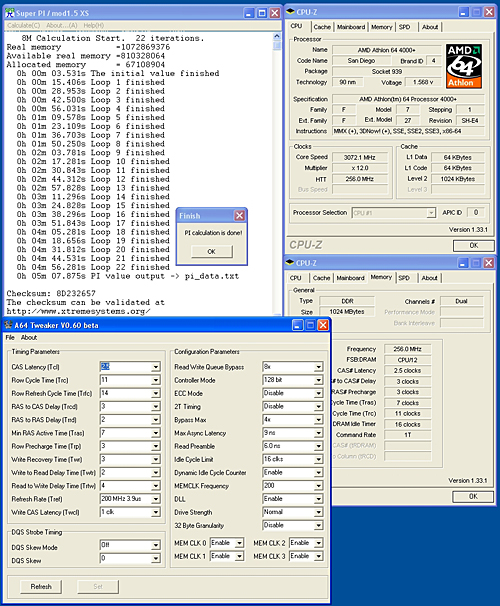 |
| Click to enlarge |
Our second test looks to see how high we can push the HTT setting while retaining the stock CPU multiplier, 1:1memory ratio, and a command rate of 1T. Our ability to reach a 12x256HTT setting is excellent and indicates a well engineered board and high quality peripherals. This setting provided our highest CPU overclock while retaining a memory setting that should be attainable for most performance oriented memory modules. We could have increased the HTT setting further but we reached the limit of our CPU on air cooling.
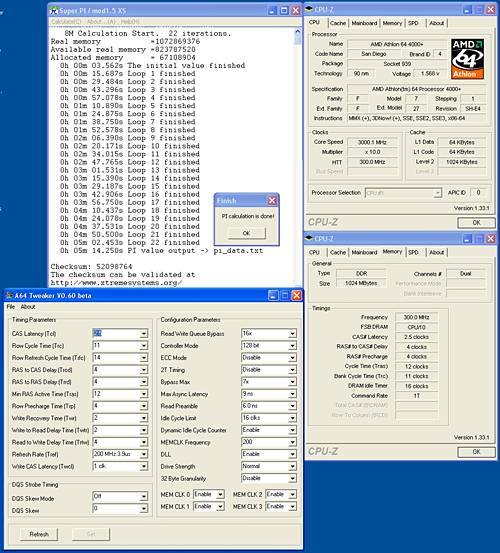 |
| Click to enlarge |
In our third test, we drop the CPU multiplier to 10X and find out how high we can push the HTT setting, knowing our CPU will do over 3GHz on air cooling. The main question is if the board will still allow us a 1:1 memory ratio and a command rate of 1T at a 300HTT or higher setting. The board answered our question in the affirmative and was able to reach a 302HTT setting before requiring the command rate to be changed to 2T, though the CPU would POST and enter XP at a 307HTT. This is interesting based upon the results of our fourth test.
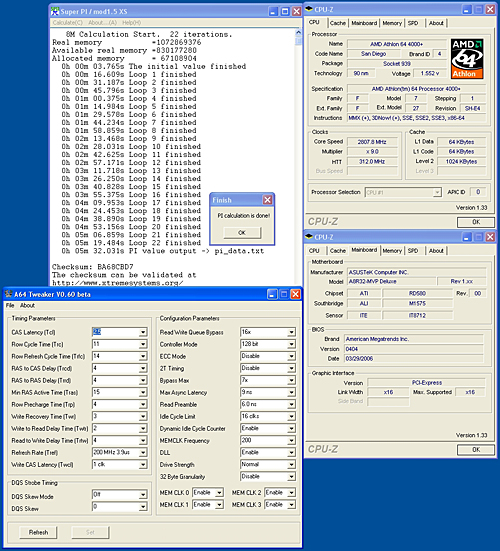 |
| Click to enlarge |
Our fourth test is designed to find the maximum HTT setting possible while utilizing the common 9X multiplier for overclocking. Our board was able to reach 312HTT while retaining the 1:1 memory ratio and 1T command rate. This is the absolute best the board would do and still pass our benchmark requirements. However, while testing at a 9X CPU multiplier we noticed several oddities during testing. The board would generate random pass results at HTT settings right above or below our test suite approved 312HTT setting. Some benchmarks would pass while others failed at one setting, and different benchmarks would pass or fail at another setting. This phenomenon did not occur once we lowered to a 307HTT setting or below.
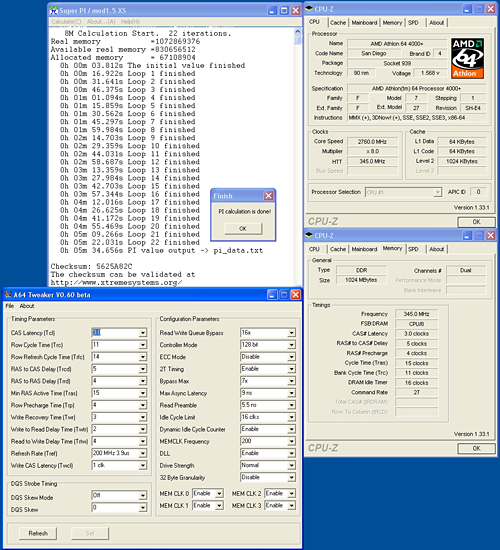 |
| Click to enlarge |
We dropped the CPU multiplier to 8X for our fifth test - the lowest multiplier anyone is likely to use for overclocking - and once again we will see what our maximum 1:1 memory ratio setting is. Our board reached a 345HTT setting while retaining the 1:1 memory ratio but required the command rate be increased to 2T. This was the maximum setting our memory would allow us in synchronous operation; any setting above a 348HTT level resulted in the board failing to POST.
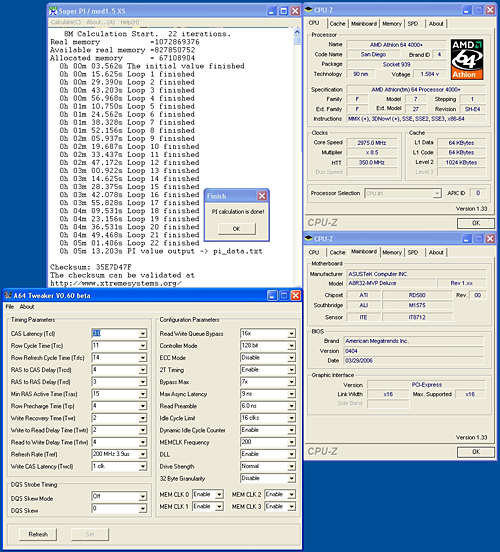 |
| Click to enlarge |
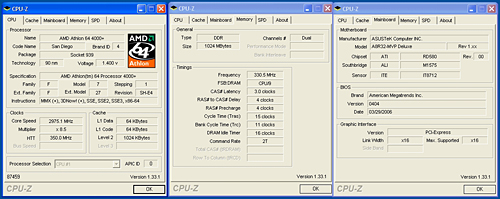 |
| Click to enlarge |
The goal of our final test is to find the maximum HTT setting while retaining a maximum CPU clock. We reached a stable 350HTT setting at a 8.5X CPU multiplier that generated at CPU clock of 2975MHz, just slightly below our maximum CPU speed. However, even though we retained a synchronous memory ratio in the BIOS, the actual memory speed was 330.5MHz (DDR-660) due to the ODC rounding effect with the multiplier setting. We will go into detail about Odd Divisor Correct and its effects on benchmarking results in a future overclocking article.
Performance Results
What good is an article without some actual performance numbers? If you dozed off during the last couple of pages, hopefully this information should be more enjoyable. While we are not providing numbers from the entire test suite there is enough information here to draw conclusions about what general settings work best in some of today's latest game engines.
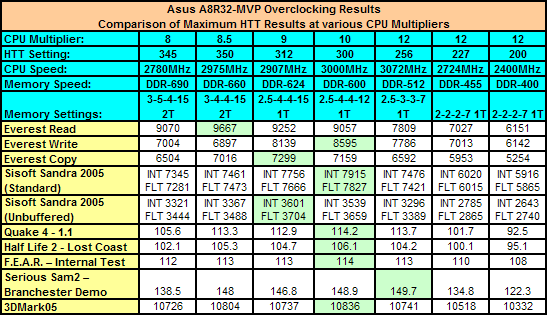
In our tests it is clear a balanced setting between maximizing the CPU clock speed while maintaining a 1:1 memory ratio with the lowest latency possible will provide the best results. No surprises there but we really expected the 9x312HTT settings to perform better. This leads us to wonder if our issues with the 9X multiplier are creating lower than anticipated results. Our favorite and highly recommended setting with this CPU/Memory/Motherboard combination is the 12x256HTT setting as it performs within 1% of the 10x300HTT setting while allowing a larger variety of memory module options to be utilized. The system also requires lower memory and chipset voltages with the added benefit of better memory timings when using higher performance modules.
In essence, you are placing your system's performance capability primarily on the CPU's ability to overclock instead of the CPU and Memory overclocks when operating at the 10x300HTT setting. There is some additional overclocking headroom on this board at the 12x256HTT setting while we just barely eked by with the 10x300HTT setup. A 12x260HTT (or higher) setting should match or exceed the 10x300HTT setup in actual application and game benchmarks.
When comparing the top results generated by the 10x300HTT setting to the stock settings we see a CPU speed increase of 25%, memory clock speed of 50%, and Sandra memory benchmarks increasing by 34%. However, this does not directly translate into the same percentage improvements in the game benchmarks. We notice an increase of 23% in Q4, 12% in Half Life 2: Lost Coast, 5% in F.E.A.R., and 22% in Serious Sam II. It is obvious that F.E.A.R. is GPU constrained while the balance of games respond very well to increases in both CPU clocks and memory bandwidth. At the stock CPU/Memory settings we overclocked our EVGA 7900GTX from 650/800 to a safe 690/850 and were rewarded with 112fps compared to our top 114fps score in F.E.A.R.
Final Comments
ASUS has provided the user community with a BIOS release that in our testing has resulted in incremental improvements in overclocking while providing additional compatibility with various components. While the 0404 BIOS will not satisfy the expectations of a hardcore enthusiast, it at least shows us ASUS is listening to the community. The board had a terrific preview, a rocky introduction, and is now maturing quite nicely. Whether the board has any further potential in it is only a question ASUS can answer, an answer we have requested. We firmly believe the ATI CrossFire Xpress 3200 (RD580) has the capability; it will be a matter of time before we find out how good it really is in this board or others.
Our only remaining questions and those of others revolve around the board's capability to exceed the 300HTT level with the memory set synchronously while maintaining a command rate of 1T. Our board had the capability to do it but we just barely made it and are still concerned with the anomalies of the 9x CPU multiplier. We do not know if this issue is with the board design, BIOS settings, or chipsets, but otherwise this board performs extremely well in all phases of usage. Since we mentioned the issue of users reporting the inability to run at a command rate of 1T with a synchronous memory setting over 300HTT, we decided to do an experiment to see what effect running at a command rate of 2T would have on the benchmark scores. Here are the final results.

In our game results there is only a 1%~2% penalty for running the system with the command rate set at 2T while the Sandra benchmarks report penalties up to 15%. Those results are pretty typical for memory subsystem improvements, as CPU cache and other aspects of the system come into play. The performance difference is something that is not noticeable in day to day activities without resorting to a benchmark. While this penalty might not be acceptable for the more avid enthusiast, it should not deter someone from purchasing this board or others based upon these results.
If you're wondering why we did an article like this, one of the reasons is to illustrate the importance of having a well tuned BIOS implementation and quality board components. You can use the best peripherals on the planet, but with a poorly coded BIOS or sub-par board components you will still achieve lackluster results. Did we achieve lackluster results? Not in our opinion, although we expected a little more from this board just as a lot of enthusiast users have since purchasing it.
With DFI and Abit shipping their RD580 socket 939 products now and with several other manufacturers planning to offer RD580 AM2 products at launch it will be interesting to see who can extract the most performance from this chipset. We currently have the DFI board in the lab for testing and will have the Abit shortly so stay tuned to see which board can best meet the expectations of the gamer and overclocking enthusiast.







